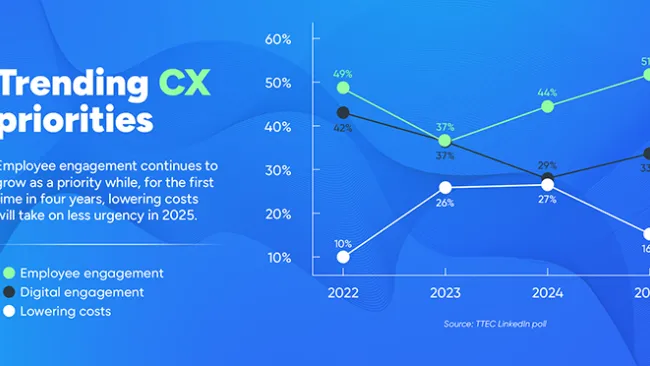Our team visited the 2020 National Retail Federation (NRF) "Big Show" in New York City to report on the latest thought leadership and technology reshaping the retail industry. To create a better picture of what work will look like this decade, we spoke to Rachel Kreuter, a communications specialist at Ceridian, about the company's recently published "2020 Future of Work" report.
Key Takeaways
- Technology needs to be seen as an enabler, not a disruptor in the workforce.
- Five generations will be sharing the same office space. That means looking at past the age stereotypes and focusing on life stages.
- Successful organizations are collaborating technology with people.
Transcript:
Dylan Haviland: Hi this is Dylan Haviland welcome to the CX Pod. This week me and my coworkers had the opportunity to go to NRF in New York. This is one of the biggest conferences for retail in the United States and we had the opportunity to see some of the biggest names in retail dish out the secrets and recipes for creating an amazing customer experience in 2020 and beyond.
So between me roaming the booths, seeing robotics, and hearing Gwyneth Paltrow talk about Goop, I had the opportunity to talk to Rachel from Ceridian on the future of workplace in 2020. They recently did a great report on it and it was inciteful to talk to her about where they see this year going in employee experience.
So you have this new report you put out, the 2020 Future of Work, can you tell me about the objective of it?
Rachel Kreuter: Yeah absolutely, Ceridian partnered with Hanover Research to discover how industry leaders are addressing various challenges and forces of change in the next decade of work. While Ceridian’s survey indicates that decision-makers believe they’ll face critical challenges and profound changes, it also revealed that organizations may not be directing their focus to high-impact, high-value actions that create long-term success.
DH: Great and who did you reach out for this report?
RK: For this report we surveyed 999 director-level and above professionals from the U.S. (71%) and Canada (29%) with companies with more than 1,000 employees. It included professionals across industries, it also included professionals from across various industries with a focus on retail, finance, manufacturing, and healthcare verticals to better understand key challenges, opportunities, and differences in these industries.
DH: You say a lot in the report that the very nature of work is changing this year. What are some of the human and artificial factors playing a part in this?
RK: As we have been hearing for some time now, there are essentially five generations in the workforce. Unemployment is at a record low. People no longer expect a traditional work day at a traditional office. So things like AI and machine learning are also changing the composition of the modern workforce and that is something we are digging into. And as well the alternative work arrangements – gig work, freelance, and crowdsourced opportunities – are increasingly becoming part of the fabric of companies overall. As organizations adjust, they’re attempting to redefine what it means to be an employee. But is enough though to redefine what it means to be an employee? I think what we seek in this report is how we need to change our mindset beyond the definition of employee, what does it really mean. We really dig deep into that.
DH: Now I really want to jump into that generation thing but for now, I wanted to focus on technology. AI, automation, and robotics are obviously playing a very big role in the work environment, how are the more progressive companies taking advantage of this?
RK: So while it’s possible that nearly 50% of jobs will be automated in the coming years, the impact of AI on businesses is projected to increase labor productivity by up to 40%. While jobs will likely change, there’s a place for humans and machines to work side by side in the future of work. And – organizations can capitalize on this and the progressive companies will and are when they are ready.
So what this may look like is in the survey we saw that in the next two years, decision-makers’ top areas of focus when it comes to tech adoption are on advanced technologies, like cloud software and Internet of Things (55%), and cognitive technologies, such as AI and ML (53%). It’s not at all surprising that there’s a great focus on cognitive technologies in the next two years. These technologies like AI and ML are specifically relevant for HR. Important decisions, such as who to hire or potentially let go, who to train and promote, or how to compensate properly, are made with a high degree of uncertainty in the absence of data and technology.
This technology can help streamline this process and help decision makers with these key decisions. Progressive companies are also going to leverage technology to streamline compliance management – from staying up to date with employee training, to keeping up with federal and regional regulatory changes. There is also evidence that technology will augment human efforts and contribute to new job creating. It’s the organizational mindset that is the challenge when it comes to technological adoption. Not so much the technology itself.
DH: That is interesting that it goes against the grain of people worrying about technology taking their jobs. Seems like they are meeting it with open arms.
RK: Something we focus in the report is leveraging technology, not seeing it as a disruptor and seeing it an enabler which is a key one. As I mentioned before, the future of work will see humans and machines working together and I think the mindset needs to change that machines will take over and we need to change it to how we can work together.
DH: And with these new technologies I can imagine that it’s going to have a great impact on skills needed in the future. What did you find regarding this?
Automation will fundamentally contribute to shaping the workforce of the future. The in-demand skills of the future are also going to look different than they did in the past decade. We project that the in demand skills are going to be industry-agnostic: soft skills like creativity, emotional intelligence, critical thinking, and communication, to name a few. The hard tech skills companies are looking for reflect an increasingly digital world and are also less industry-specific, such as UX design, cloud computing, and Ai competencies to name a few as well. Our survey revealed that decision-makers recognize they’re in the eye of the storm – only 11% of respondents said their companies are experiencing neither a skills gap or labor shortage that just shows you the extent. The report also shows that 45% of respondents reported to be experiencing a skills gap, and 29% reported to be experiencing a general labor shortage. Which is interesting to know.
DH: I saw this really interesting stat you shared that 65% of children in primary school are going to have jobs that don’t exist today. So going forward how can leaders make brands more rewarding and attractive to these future skills?
RK: Short answer by being more progressive to attract and develop future skills. According to the survey, the top two strategies organizations are prioritizing to address the skills gap are reskilling the existing workforce (74%) and investing in succession planning (71%) What we can organizations do that they aren’t doing at this time is emphasize the importance of creation of education, experience, and exposure opportunities to help close the skills gaps.
Partnerships with organizations and educational entities could be a key drive in addressing skills gaps before they occur. So homing in on schools and universities and high school, addressing that before it happens. That requires reimagination and thinking by HR. Developing talent to its fullest potential extends well beyond the walls of the workplace, and the onus is partly on employers to help prepare future workers from a younger age. Organizations need to reimagine their learning programs as ongoing, lifelong educational initiatives. Part of the reason we face a skills gap is because we don’t give people time to learn what they need to in order to enhance their productivity. It’s important to home in on your current employees as well as go into the schools and start that journey.Leaders have to think about this far beyond providing reimbursements for training and certifications, and be more progressive in their approaches.
So essentially being more creative and progressive in their approach.
DH: Going back into the now I remember you mention that 5 generations are going to be in the same workforce. So how can leaders make the most out of this diverse environment?
RK: To make the most of a varied workforce, organizations should focus less on perceived generational differences, and more on life stages and personalizing the employee experience. Our research revealed that while the majority of respondents (62%) agreed that a multi-generational workforce increases productivity, they were also just as likely to observe challenges with an age-diverse workforce, ranging from different learning styles and capabilities to differing preferences for communication, and more.
In the report our Chief People and Culture officer Lisa Sterling said that anyone aiming to solve a multi-generational workforce issue by implementing diversity and inclusion initiatives is doing it for the wrong reasons. Building an inclusive culture goes far beyond addressing generational differences. She also says that we should be focused on meeting people where they’re at in their lives no how to deal with the multi-generational workforce. All people want the same trust, power, and respect. What they need might be different, depending on their stage of life – not specifically about age.
DH: What do you think is the biggest take way from the report?
RK: While organizations can’t control the forces driving change, they can control how they leverage their most valuable asset – their people. In a world of work that will be increasingly defined by the collaborations between humans and technology, successful organizations will seek opportunities to enhance and derive value from these collaborations. This requires a strategy that is transformational, not simply reactive. It needs an approach to managing people that is holistic, not siloed, and mindset about technology that is inclusive, not fearful.
DH: Anything you’ll like to add?
RK: View technological developments as opportunities to transform, support, and elevate how your people do their work. And one thing I forgot to mention, the alternative workforce is here to stay, it’s already arrived and employers need to optimize that to their betterment.














